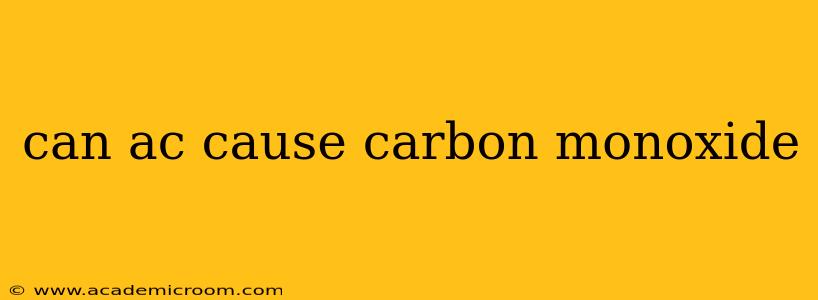Can AC Cause Carbon Monoxide? Understanding the Risks
The short answer is: yes, an air conditioner can indirectly cause carbon monoxide (CO) buildup, but it's not the AC unit itself producing the CO. The danger lies in malfunctions or improper installations that lead to CO leaks from other sources. Let's explore this in detail.
An air conditioner doesn't inherently produce carbon monoxide. CO is a byproduct of incomplete combustion of fuels like natural gas, propane, or gasoline. Therefore, the link between AC units and CO poisoning is often indirect and stems from related appliances or situations.
How Can an AC Unit Indirectly Lead to Carbon Monoxide Buildup?
Several scenarios can create a dangerous situation:
-
Malfunctioning Furnaces or Boilers: In some homes, the AC unit shares a duct system with the furnace or boiler. If these appliances malfunction and produce CO, the contaminated air can be circulated throughout the house by the AC system, increasing exposure risks. A cracked heat exchanger in a furnace is a prime culprit here.
-
Improper Ventilation: Poorly ventilated spaces, especially basements or garages where furnaces or other combustion appliances are located, can trap CO. If the AC system is drawing air from these areas, it can distribute the dangerous gas into living spaces.
-
Blocked Exhaust Vents: Blocked or improperly installed exhaust vents for furnaces, water heaters, or other combustion appliances can cause a buildup of CO. The AC, while not the direct cause, can then circulate this trapped CO within the home.
-
Generator Issues: If using a generator during a power outage, improper ventilation can lead to CO accumulation. The AC running might draw in this CO from outside if the generator is placed too close to the intake vents.
What are the Symptoms of Carbon Monoxide Poisoning?
Recognizing the symptoms of CO poisoning is crucial for early intervention. Symptoms can be subtle and easily mistaken for other illnesses, including:
- Headache: This is often one of the first symptoms.
- Dizziness: Feeling lightheaded or unsteady.
- Weakness: General fatigue and lack of energy.
- Nausea and Vomiting: Gastrointestinal distress.
- Shortness of Breath: Difficulty breathing.
- Confusion: Mental disorientation or difficulty concentrating.
- Chest Pain: In severe cases.
How Can I Prevent Carbon Monoxide Poisoning Related to My AC?
- Regular Maintenance: Schedule annual inspections of your furnace, boiler, and other combustion appliances by a qualified technician. This includes checking for cracks in the heat exchanger and ensuring proper ventilation.
- Proper AC Installation: Ensure your AC unit is installed correctly, with proper ventilation and air intake points. Avoid intakes located near potential CO sources.
- CO Detectors: Install battery-powered CO detectors on every level of your home, including near bedrooms. Test them regularly to ensure they are functioning correctly.
- Ventilation: Maintain adequate ventilation in areas where combustion appliances are located.
- Generator Safety: If using a generator, place it far away from windows and air intakes and ensure proper ventilation.
Should I be Concerned if My AC is New?
While newer AC units are generally safer, it's still important to be aware of the potential indirect risks mentioned above. Regular maintenance and CO detectors remain crucial for safety, regardless of the age of your AC unit.
By understanding the indirect relationship between AC units and CO, and taking appropriate preventative measures, you can significantly reduce the risk of carbon monoxide poisoning in your home. If you suspect a CO leak, evacuate your home immediately and call emergency services.
